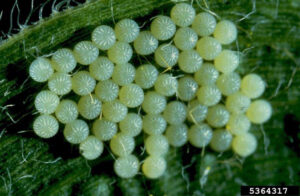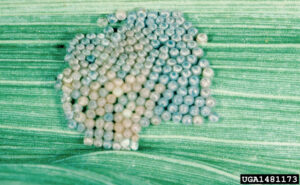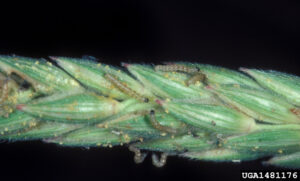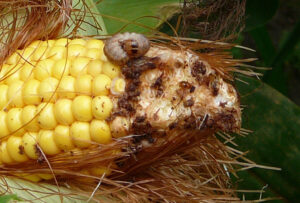- The western bean cutworm is native to the Colorado, Wyoming, and Idaho area. It migrated eastward to Ontario and New York by 2008, and had continued to migrate to the Maritimes by 2017.
- The primary host plants include corn and dry beans, but not soybean.
- To date, females have not been found to lay eggs on snap beans (green beans). However, if eggs are placed on snap beans the larvae will complete development.
Biology
There is a single generation per year. Larvae overwinter in the soil and moths can emerge as early as June and last until September, but the peak emergence period is mid-July. The adult moth is an active flier at night and can be found resting in the whorl of corn during the day. Females can oviposit up to 600 eggs over their life, and the average lifetime production is about 380 eggs. The female deposits eggs on the upper surface of corn leaves during vegetative growth stages, and after tasseling the switches to laying eggs on the leaves closest to the ear or on the ear itself. Newly deposited eggs are bright white and barrel-shaped, and laid with an average of about 50 eggs per mass (Figure 1). Prior to hatching, the eggs become purple (Figure 2), which is caused by the color of the head capsule of the larvae showing through the eggshell. Depending on temperature, egg hatch can occur five to seven days after oviposition.

Figure 1. Newly deposited egg mass laid by a western bean cutworm. Note the bright white color. Frank Peairs, Colorado State University, Bugwood.org.

Figure 2. Egg mass laid by a western bean cutworm, just prior to hatch. Note the purple color; light-colored eggs are infertile or parasitized. Frank Peairs, Colorado State University, Bugwood.org.
Larvae consume their eggshells, and the subsequent feeding behavior of the larvae depends on the developmental stage of the plant. If the corn plant is in the VT stage, the larvae move to the tassel and feed on the tassel tissue and developing anthers (Figure 3). This feeding does not result in economic injury.
If the tassel has emerged, the larvae can be found in leaf axils feeding on dropped anthers and pollen. Larvae will also feed on silks at this stage. Upon the conclusion of pollen shed, larvae move to the ear tip and feed on developing kernels (Figure 4).
Larvae in the early developmental stages have subdued diamond shapes along the back, while mature larvae have brown bands behind the head.
Mature larvae feed on the ear tip and tunnel into the side of the ear to access the kernels. Larvae disperse from the plant where the eggs were deposited to infest neighboring plants, both within and across the row. After completing at least six growth stages in about 55 days, the larvae drop to the soil and burrow to create an earthen overwintering chamber. Depending on soil texture the overwintering chambers can be at a depth of 16 inches in coarse soil, but on average are found about 8 inches deep across soil types. Winter mortality rates under natural conditions are about 60%, with higher rates of survival in coarse-textured soils.

Figure 3. First instar larvae feeding on pollen and pollen sacs. Frank Peairs, Colorado State University, Bugwood.org.

Figure 4. Western bean cutworm larvae; note the brown bands behind the head. The bands are only present on later larval growth stages.
Injury
Injury caused by western bean cutworm larvae is usually randomly distributed across the field as the yield map in Figure 5 indicates, with the red areas being heavily infested. The later growth-stage larvae destroy kernels at the tip of the ear and along the ear. Most larvae are found within five and a half feet of the original plant. This movement to adjacent plants can lead to many injured ears. The entry point through the husk—caused when larvae tunnel into the ear—can allow entry to pathogens, resulting in ear rots and possible mycotoxin production. Ear tip feeding may be confused with corn earworm injury, but while there is usually only one corn earworm located on each ear, plants infested with western bean cutworm often have multiple larvae feeding on a single ear. Direct kernel consumption equates to an average loss of just less than four bushels per acre to 15 bushels per acre.

Figure 5. Yield map of field infested with western bean cutworm. Red areas are heavily infested.
Management
Preventative tactics
The Bacillus thuringiensis (Bt) protein Vip3A is currently the only Bt protein that helps to provide control of the western bean cutworm. Corn products with Trecepta® Technology contain the Vip3Aa20 protein and can help provide control. Other cultural practices such as altering planting date and tillage to destroy the pupal cells are of limited value.
Responsive tactics
The correct timing of scouting for western bean cutworm can be refined using either pheromone traps near corn fields or a developmental model
that predicts moth emergence. While both tactics may assist in scouting timing, they cannot be used to determine the need for a responsive management tactic. Scouting timing should be focused on the corn developmental stage at mid-June through July. The female western bean cutworm moth prefers to deposit her eggs on plants that are just about to tassel. While oviposition in some years can occur on whorl-stage corn, the larvae do not survive feeding on vegetative tissue alone and need to consume plant reproductive tissue or pollen to complete their development.
Sampling consists of counting the number of egg masses or small larvae on 20 consecutive plants, in five locations throughout the field due to oviposition being random across the field. Scouting should be continued on a five-day schedule until the oviposition period is complete. In years with extreme growth stage variability across the field, oviposition in the field may occur over a longer period.
If the risk of mycotoxins is minimal and the major concern is direct injury, then an economic threshold of 5 to 8 percent of the plants infested with egg masses or small larvae should be used. In areas where mycotoxins are a concern, the lower economic threshold of 5 percent infested plants should be used. In addition, the economic threshold in this situation is additive. For example, if the infestation rate is 2 percent for the first sampling, and five days later
the second sampling found 3 percent of the plants were infested, then the threshold would be reached (2% + 3% = 5%). Additionally, if mycotoxins are
a concern, the addition of a fungicide with the insecticide applied at R1 is recommended.
Insecticide and fungicide recommendations can change, so please consult your chemical provider for registered approved products.
Additional Resources
Smith, J.L., Difonzo, C.D., Baute, T.D., Michel, A.P., Krupke, C.H. 2019. Ecology and management of the western bean cutworm (Lepidoptera: Noctuidae) in corn and dry beans—Revision with focus on the Great Lakes region. Journal of Integrated Pest Management, 10: 1-19. https://academic.oup.com/jipm/article/10/1/27/5558144.
Legal Statements
Bayer is a member of Excellence Through Stewardship® (ETS). Bayer products are commercialized in accordance with ETS Product Launch Stewardship Guidance, and in compliance with Bayer’s Policy for Commercialization of Biotechnology-Derived Plant Products in Commodity Crops. Commercialized products have been approved for import into key export markets with functioning regulatory systems. Any crop or material produced from this product can only be exported to, or used, processed or sold in countries where all necessary regulatory approvals have been granted. It is a violation of national and international law to move material containing biotech traits across boundaries into nations where import is not permitted. Growers should talk to their grain handler or product purchaser to confirm their buying position for this product. Excellence Through Stewardship® is a registered trademark of Excellence Through Stewardship. ALWAYS READ AND FOLLOW PESTICIDE LABEL DIRECTIONS. B.t. products may not yet be registered in all states. Check with your seed brand representative for the registration status in your state. Performance may vary, from location to location and from year to year, as local growing, soil and environmental conditions may vary. Growers should evaluate data from multiple locations and years whenever possible and should consider the impacts of these conditions on their growing environment. The recommendations in this material are based upon trial observations and feedback received from a limited number of growers and growing environments. These recommendations should be consid-ered as one reference point and should not be substituted for the professional opinion of agronomists, entomologists or other relevant experts evaluating specific conditions. IMPORTANT IRM INFORMATION: Certain products are sold as RIB Complete® corn blend products, and do not require the planting of a structured refuge except in the Cotton-Growing Area where corn earworm is a significant pest. Products sold without refuge in the bag (non-RIB Complete) require the planting of a structured refuge. See the IRM/Grower Guide for additional information. Always read and follow IRM requirements. Roundup Ready® 2 Technology contains genes that confer tolerance to glyphosate. Plants that are not tolerant to glyphosate may be damaged or killed if exposed to those herbicides. Insect control technology provided by Vip3A is utilized under license from Syngenta Crop Protection AG. Bayer, Bayer Cross, RIB Complete®, Roundup Ready® and Trecepta® are registered trademarks of Bayer Group. Agrisure Viptera® is a registered trademark of a Syngenta group company. Respect the Refuge and Corn Design® and Respect the Refuge® are registered trademarks of National Corn Growers Associa-tion. All other trademarks are the property of their respective owners. ©2024 Bayer Group. All rights reserved. 1215_67368

